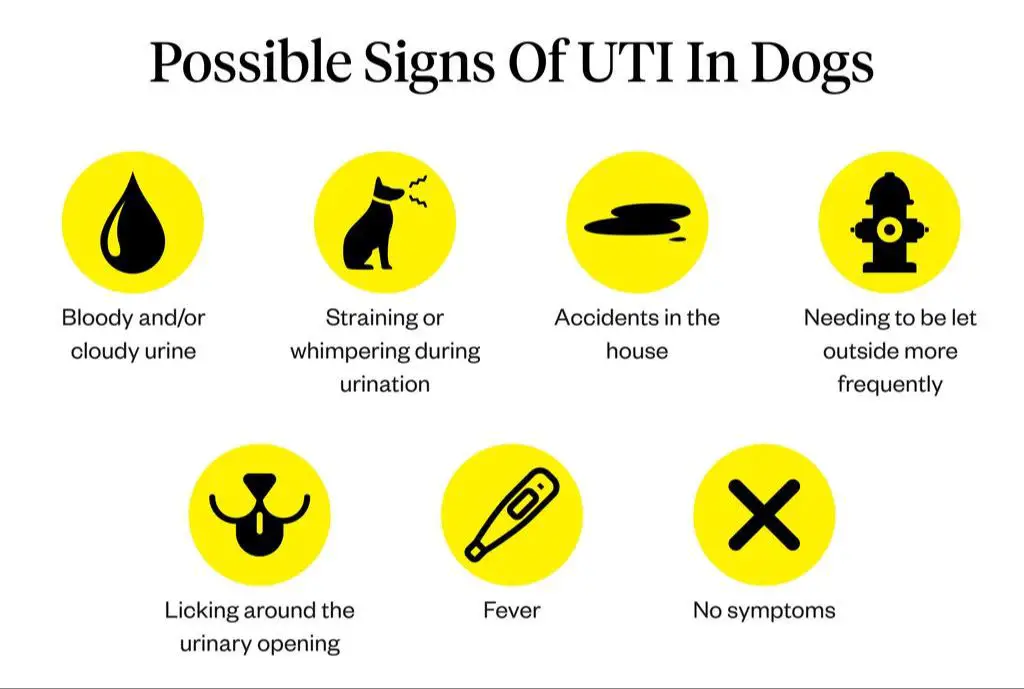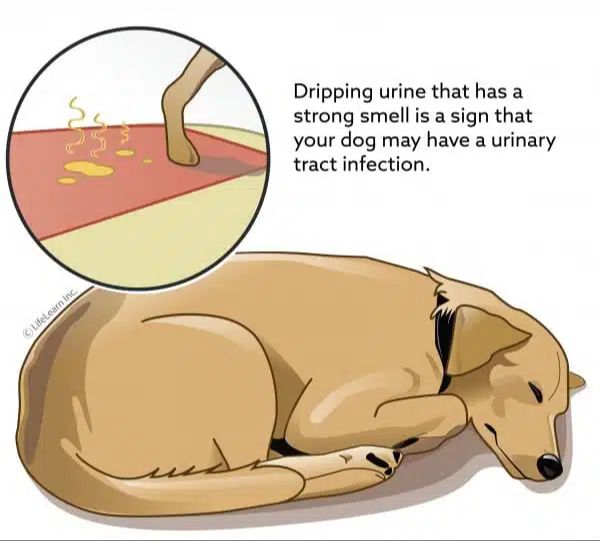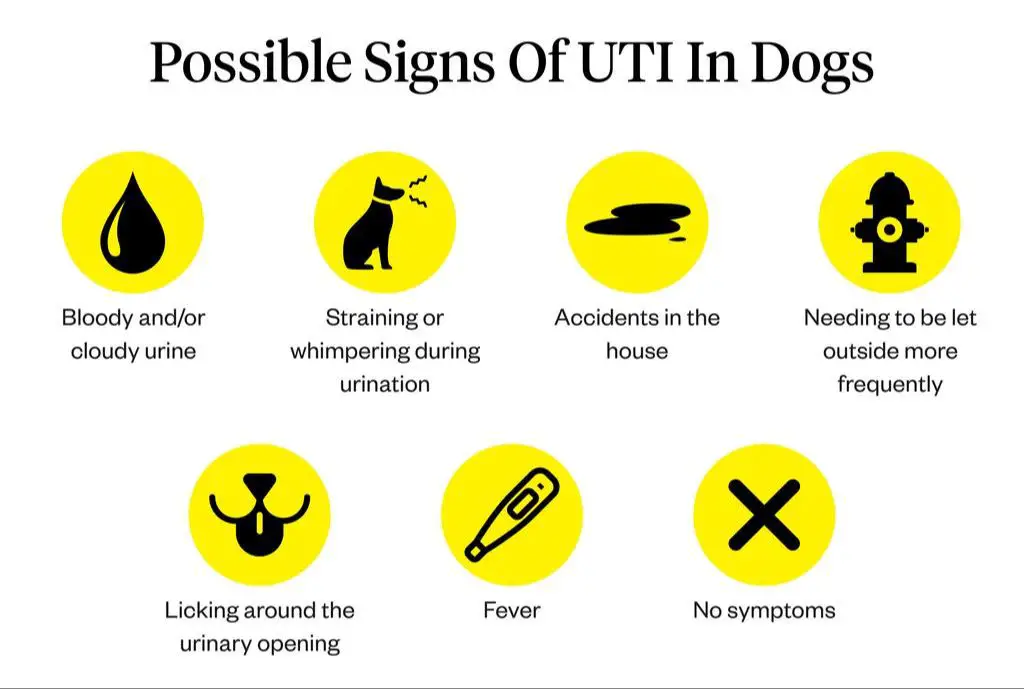Introduction
Bladder infections are relatively common in dogs, particularly males. They occur when bacteria, often E. coli from the GI tract, enters the urethra and travels up to the bladder, multiplying and causing infection and inflammation of the bladder wall. Smaller male dogs are especially at risk, since their urethra is narrower.
Bladder infections in male dogs are more common because their urethra is longer than in females, allowing more opportunity for bacteria to enter. Some breeds like Chihuahuas, Miniature and Standard Poodles, Shetland Sheepdogs, and Cocker Spaniels have predispositions. Risk factors include urinary crystals, urinary stones, prostate disease, urinary incontinence, diabetes, a weak immune system, and urinary catheters.
Symptoms
Male dogs with bladder infections can exhibit a variety of symptoms. Some of the most common symptoms of a bladder infection in male dogs include:

Frequent urination: One of the classic signs of a bladder infection in dogs is an increased urge to urinate. You may notice your male dog asking to go outside more often and having accidents in the house.
Discomfort when urinating: In addition to urinating more often, your dog may experience pain or discomfort when trying to urinate. He may whine, whimper, or strain while peeing.
Blood in urine: Due to inflammation and irritation in the bladder, you may notice blood in your dog’s urine. The urine may appear pink or red tinged when your dog pees.
Leakage: Some dogs with a bladder infection can’t control their bladder as well and may leak urine in the house. You may notice wet spots where your dog was laying or sitting.
Licking genitals: The inflammation and discomfort caused by the infection may cause your dog to excessively lick his genital area. He may lick himself before and after urinating.
Causes
There are several potential causes of bladder infections in male dogs:
Bacteria: The most common cause of bladder infections in dogs is bacteria, usually E. coli from the GI tract. The bacteria enters the urethra and travels to the bladder, causing an infection.
Anatomical abnormalities: Some dogs may have anatomical defects like urinary tract stones, tumors, narrowed urethra, or abnormal urethral opening that allow bacteria to enter the bladder more easily.
Bladder stones: Bladder stones (uroliths) can cause abrasions in the bladder wall, allowing bacteria to more readily adhere and enter tissue. Stones also allow urine to pool, encouraging bacterial growth.
Tumors: Tumors in the urinary tract or prostate can block urine flow, leading to pooling of urine and bacterial growth. Tumors may also physically damage protective linings that prevent infection.
Prostate disease: Prostate disease, inflammation, enlargement, or abscess can physically block the urethra. This allows urine to pool, which encourages bacterial growth and infection.
Diagnosis

If your vet suspects a bladder infection, they will likely run the following diagnostic tests:
Urinalysis
A urinalysis involves examining a urine sample under a microscope to look for bacteria, red blood cells, white blood cells, and crystals. This is usually the first test performed when a urinary tract infection is suspected. An elevated white blood cell count indicates inflammation and infection.
Urine Culture
A urine culture is the gold standard for diagnosing a bladder infection. The urine sample is incubated in a laboratory to allow any bacteria present to multiply. This allows the vet to identify the specific bacteria causing the infection and test different antibiotics to see which medication will be most effective.
Abdominal Ultrasound
An ultrasound uses soundwaves to create images of the bladder and other internal organs. This allows the vet to check for bladder stones, tumors, anatomical abnormalities, or obstructions that could be predisposing factors for recurrent infections.
Cystoscopy
A cystoscopy involves inserting a narrow tube with a camera on the end (cystoscope) into the urethra to directly visualize the inside of the bladder. This procedure can identify bladder stones, polyps, masses, or other abnormalities. Biopsies can also be taken if needed.
Treatment for Male Dog Urinary Tract Infections
Treatment for urinary tract infections in male dogs often includes a course of antibiotics, diet modifications, increased fluid intake, and medication for pain relief:
Antibiotics
Veterinarians typically prescribe oral antibiotics like amoxicillin or enrofloxacin to treat the bacterial infection causing the UTI. The course of antibiotics is usually 2-4 weeks. It’s important to give the full course as prescribed to prevent recurrence. Antibiotics specific for urinary tract infections help clear the infection from the bladder and urinary tract.
Diet Change
Switching to a prescription urinary health diet can help manage UTIs. These diets create an environment in the bladder that inhibits bacterial growth. They are lower in magnesium and promote dilution of the urine. Your vet may recommend a temporary or long-term diet change.
Fluids
Increasing your dog’s fluid intake can help flush bacteria from the urinary tract. Give your dog more opportunities to drink fresh water. You can also add extra moisture to his food or feed canned food temporarily. Your vet may recommend administering subcutaneous fluids at home.
Pain Medication
Your vet may prescribe pain relievers if your dog is straining or showing signs of discomfort when urinating. Medications like Phenylpropanolamine can help relax the urethra and make urination more comfortable. Opioid pain relievers may also be used short-term.
Home Care
There are some simple things you can do at home to help care for your dog if he has a bladder infection:

Increased water intake – Make sure your dog has constant access to fresh, clean water. Increased water intake helps flush bacteria from the urinary tract. You may need to fill his water bowl more frequently or get a larger water bowl.
Urination assistance – Take your dog outside to urinate more frequently, at least every 2-4 hours if possible. Allow your dog ample time to empty his bladder fully. Give your dog privacy without interruption when urinating.
Sanitary genital area – Gently wipe your dog’s genital area with unscented baby wipes after urination to remove any bacteria. Keep the hair around the genitals trimmed short for cleanliness and inspection.
Prevention
There are several ways to help prevent bladder infections in male dogs:

Good Hygiene
Keeping the genital area clean can help prevent bacteria from entering the urethra and causing an infection. Gently wipe the area with unscented baby wipes after your dog urinates or defecates.
Urination Schedule
Take your dog out to urinate at least 3-4 times per day. Allowing the bladder to get too full can increase the likelihood of bacteria multiplying and cause an infection. Stick to a routine so your dog fully empties their bladder each time.
Diet
Feed your dog a high-quality diet and ensure they have access to plenty of fresh water. Stay away from foods high in sugars, carbs, and fillers which can alter the pH balance in the bladder.
Early Treatment
If you notice any possible symptoms of a bladder infection, contact your veterinarian right away for testing and treatment. Treating it early can help resolve the infection faster and prevent it from worsening or recurring.
Complications
Some of the potential complications of bladder infections in male dogs include:
Kidney Infections
If left untreated, a bladder infection can spread to the kidneys. This is known as pyelonephritis. It allows bacteria to enter the bloodstream and can cause kidney damage. Symptoms of a kidney infection include increased urination, blood in the urine, fever, vomiting, and diarrhea. Kidney infections are serious and require urgent veterinary treatment with antibiotics and fluids.
Sepsis
Sepsis is a life-threatening condition caused by the body’s immune response to an infection. Bacteria from a bladder infection can enter the bloodstream and cause sepsis. Symptoms include fever, rapid heart rate and breathing, shivering, weakness, and mental confusion. Sepsis requires emergency veterinary care to prevent organ failure and death.
Urethral Obstructions
Some male dogs may develop obstructing bladder stones or crystalline plugs that block the flow of urine. This is a medical emergency that causes the bladder to rupture. Symptoms include straining to urinate, crying out in pain, frequent attempts to urinate with little production, and bloody urine. Urethral obstructions need immediate veterinary catheterization and surgery.
Prognosis
With prompt diagnosis and proper treatment, the prognosis for dogs with bladder infections is generally good. Most dogs will make a full recovery within 1-2 weeks when treated with the appropriate medications prescribed by a veterinarian.
However, some dogs may experience recurring infections, especially if an underlying cause is not identified and addressed. Dogs with anatomical abnormalities like bladder stones or tumors are at higher risk of recurrence. Regular urinalysis testing may be recommended to monitor for recurrence.
In most cases, quick treatment prevents the infection from spreading to the kidneys. When caught early, urinary tract infections rarely lead to long-term kidney damage or other serious complications in dogs.
Working closely with your veterinarian and following treatment instructions is key to ensuring your dog makes a full recovery and preventing recurrence. Routine wellness exams and testing for at-risk dogs can also help reduce the likelihood of repeat infections.
When to See a Vet
It’s important to monitor your dog closely when he has a bladder infection. While mild infections may clear up on their own, more serious cases require veterinary care. Contact your vet right away if your dog has any of the following symptoms:
- Persistent symptoms – If your dog continues to have frequent urination, straining, or other symptoms beyond a couple of days, he likely needs medical treatment. Bladder infections can worsen and spread to the kidneys if left untreated.
- Lethargy – A lack of energy or interest in normal activities may signal a more advanced infection. Your dog may appear depressed or fatigued.
- Vomiting – Throwing up is not a typical sign of a bladder infection but may indicate a secondary issue like a kidney infection or obstruction. Vomiting requires prompt veterinary attention.
- High fever – An elevated body temperature over 103oF could mean the infection has spread. Take your dog’s temperature rectally if he seems ill.
In addition, contact your vet if your dog’s symptoms worsen or he does not improve within 2-3 days of starting home treatment. Dogs with weak immune systems may be more prone to severe infections. When in doubt, do not wait – seek veterinary care right away.